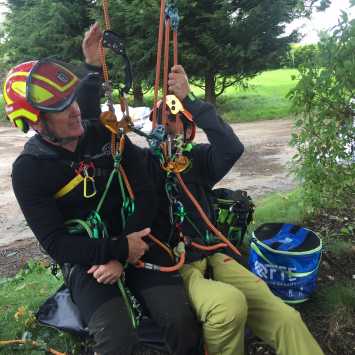Single Rope Technique has been a component of my commercial arb work since the early 2000s and has undergone various evolutions (see earlier blog post) from initial discrete access only systems, to the current access and positioning techniques. Much of this development has occurred outside the UK training and assessment framework. This has been driven by geography, with much innovation being elsewhere in the world. Another reason for this is because of our industries rather one-dimensional approach to work at height training and assessment. Internet and YouTube proliferation of techniques and ideas from the useful, through to the bizarre and downright dangerous, has sped up dissemination of ideas. This sets the scene for our early efforts to raise awareness around SRT with our own workshops; other courses such as Tree kit and the US TCIA have become available.
Lantra Awards ran a series of re-certification events last year for their aerial instructors (see blog) - interestingly, these have been picked up by City & Guilds this year for those assessors who either missed the Lantra event or who only assess.
One outcome of these events was a desire to develop a more extensive offering of instructor CPD and training as well as acknowledging the substantial move away from the ‘basic’ techniques and systems taught on introductory courses. Instructors would be invited, rather than compelled to attend.
John Trenchard & Chalky White developed the course, workbook and assessment over the winter and ran a couple of Lantra myth-busting roadshows at the APF and AA Arb show. Two dates in late August were offered for prospective Lantra Instructors to be evaluated and for the course content to be standard set. I went to the second course and met up with five other instructors from all over the UK at Lantra House in Stoneleigh Park.
After a short introduction and brief discussion, on the recent HSE/AA meeting around the definitions and requirements of work positioning and rope access, we adjourned to the nearby Nailcote Golf Club where a range of trees had been chosen for the two-day course. Unusually there was artificial grass under the leading group; this offered a clean surface to work on. the first task was to set up a range of canopy anchors and look at the pros and cons in terms of complexity, rope on rope interactions and retrievability. Ideas and thoughts were shared and discussed. Then followed a range of tasks in a similar format: building on setups at the base, throwline installation, leading to CE compliant system set up and testing and then progression to a suitable final anchor point. A range of redirects was investigated, with the emphasis on avoiding slack build up.
Day two had a primary focus on rescues again with sequential tasks and standard-setting discussions. We were encouraged to experiment with different options in addition to the workbook ideas.
The Lantra Awards course is a welcome development in this area of tree climbing techniques, as it offers the following benefits:
- SRWP framed within the UK established tree climbing principles
- Lantra Awards course with workbook
- Optional independent Lantra Awards benchmark assessment
- SRWP options demonstrated in compliance with UK Work @ Height Regs.
- Rescue focus based on sensible defendable approaches
- Dangerous/marginal practices rejected
- Emphasis on CE/EN compliant PPE
HSE context
Course Objectives
- Understand Stationary Rope Work Positioning for Tree Climbing
- Identify a range of Personal Protective Equipment (PPE) appropriate to tree climbing
- Identify hazards and manage associated risks
- Carry out visual tree inspection
- Carry out a pre-use inspection of tree climbing equipment
- Choose necessary anchor points
- Use techniques for safe and efficient ascent and descent
- Establish safe and comfortable work positions
- Carry out SRWP rescue methods
Who is it for?
Prerequisites - City & Guilds or Lantra Awards Benchmark Basic Tree climbing unit, as well as a right level of fitness.
The course is suitable for those new to SRWP but would generally not be suitable to those relatively new to climbing.
For those getting interested in SRWP and already working on a fixed line, it would be ideal, and even those proficient can gain a lot in terms of simplifying setups and rescue systems.
We’re pleased to be able to offer this new Lantra Awards course and, irrespective of the Work@Height Reg definitions, I feel that anyone already using or contemplating SRWP would be materially safer having done the course, considering the actual risks that arise from tree climbing and working with cutting tools in the tree. That’s for another article perhaps…




